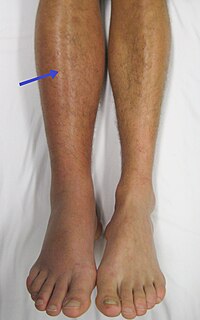
Photo from wikipedia
Importance The efficacy of anti–factor Xa (anti-Xa)–guided dosing of thromboprophylaxis after trauma remains controversial. Objective To assess whether dosing of enoxaparin sodium based on peak anti-Xa levels is associated with… Click to show full abstract
Importance The efficacy of anti–factor Xa (anti-Xa)–guided dosing of thromboprophylaxis after trauma remains controversial. Objective To assess whether dosing of enoxaparin sodium based on peak anti-Xa levels is associated with the venous thromboembolism (VTE) rate after trauma. Design, Setting, and Participants Retrospective review of 950 consecutive adults admitted to a single level I trauma intensive care unit for more than 48 hours from December 1, 2014, through March 31, 2017. Within 24 hours of admission, these trauma patients were screened with the Greenfield Risk Assessment Profile (RAP) (possible score range, 0-46). Patients younger than 18 years and those with VTE on admission were excluded, resulting in a study population of 792 patients. Exposures The control group received fixed doses of either heparin sodium, 5000 U 3 times a day, or enoxaparin sodium, 30 mg twice a day. The adjustment cohort initially received enoxaparin sodium, 30 mg twice a day. A peak anti-Xa level was drawn 4 hours after the third dose. If the anti-Xa level was 0.2 IU/mL or higher, no adjustment was made. If the anti-Xa level was less than 0.2 IU/mL, each dose was increased by 10 mg. The process was repeated up to a maximum dose of 60 mg twice a day. Main Outcomes and Measures Rates of VTE were measured. Venous duplex ultrasonography and computed tomographic angiography were used for diagnosis. Results The study population comprised 792 patients with a mean (SD) age of 46 (19) years and was composed of 598 men (75.5%). The control group comprised 570 patients, was older, and had a longer time to thromboprophylaxis initiation. The adjustment group consisted of 222 patients, was more severely injured, and had a longer hospital length of stay. The mean (SD) RAP scores were 9 (4) for the control group and 9 (5) for the adjustment group (P = .28). The VTE rates were similar for both groups (34 patients [6.0%] vs 15 [6.8%]; P = .68). Prophylactic anti-Xa levels were reached in 119 patients (53.6%) in the adjustment group. No difference in VTE rates was observed between those who became prophylactic and those who did not (7 patients [5.9%] vs 8 [7.8%]; P = .58). To control for confounders, 132 patients receiving standard fixed-dose enoxaparin were propensity matched to 84 patients receiving dose-adjusted enoxaparin. The VTE rates remained similar between the control and adjustment groups (3 patients [2.3%] vs 3 [3.6%]; P = .57). Conclusions and Relevance Rates of VTE were not reduced with anti-Xa–guided dosing, and almost half of the patients never reached prophylactic anti-Xa levels; achieving those levels did not decrease VTE rates. Thus, other targets, such as platelets, may be necessary to optimize thromboprophylaxis after trauma.
Journal Title: JAMA Surgery
Year Published: 2018
Link to full text (if available)
Share on Social Media: Sign Up to like & get
recommendations!